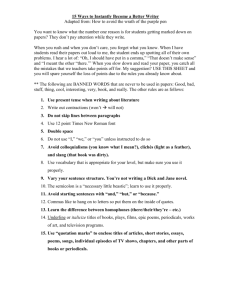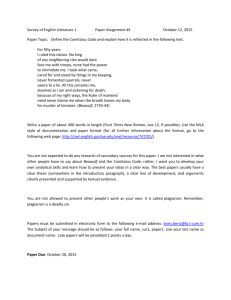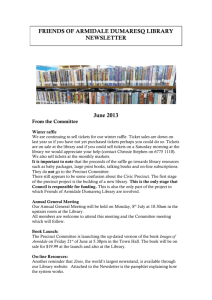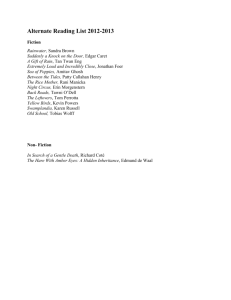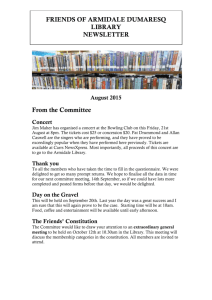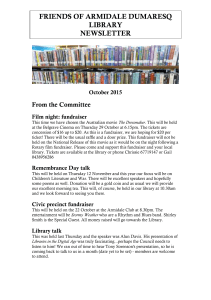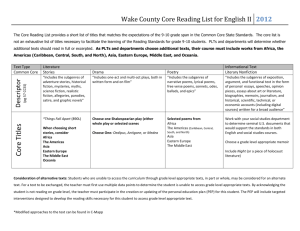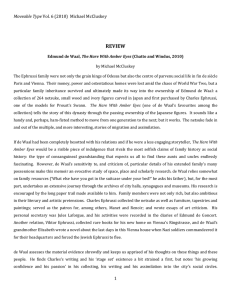Armidale Dumaresq Council Community Strategic Plan
advertisement
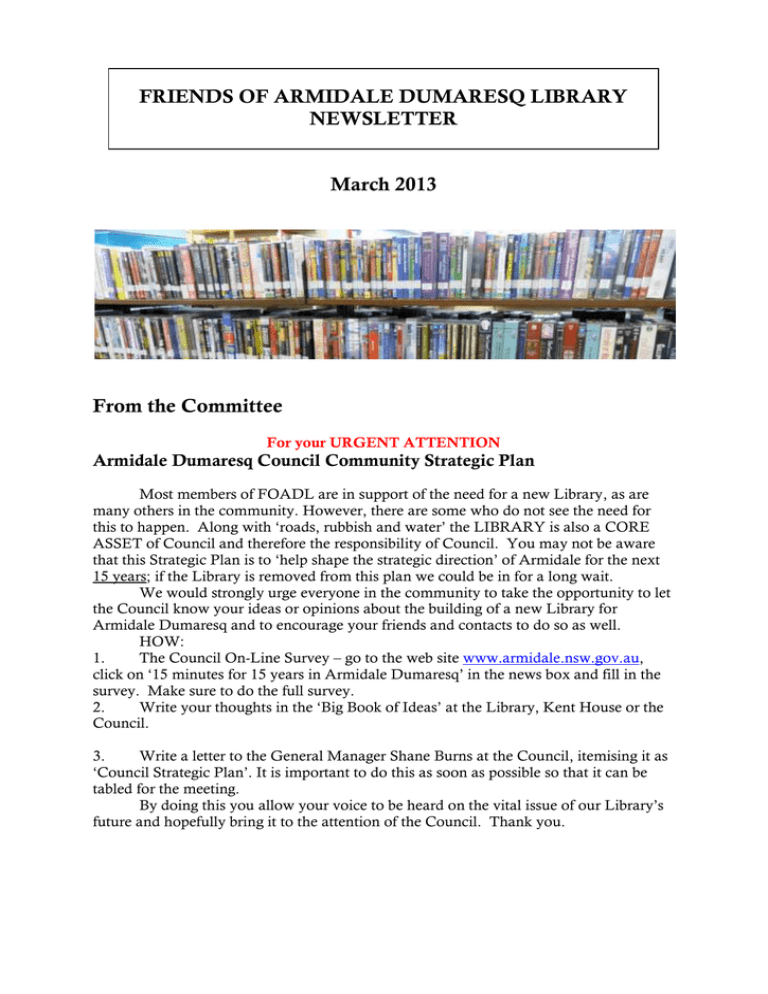
FRIENDS OF ARMIDALE DUMARESQ LIBRARY NEWSLETTER March 2013 From the Committee For your URGENT ATTENTION Armidale Dumaresq Council Community Strategic Plan Most members of FOADL are in support of the need for a new Library, as are many others in the community. However, there are some who do not see the need for this to happen. Along with ‘roads, rubbish and water’ the LIBRARY is also a CORE ASSET of Council and therefore the responsibility of Council. You may not be aware that this Strategic Plan is to ‘help shape the strategic direction’ of Armidale for the next 15 years; if the Library is removed from this plan we could be in for a long wait. We would strongly urge everyone in the community to take the opportunity to let the Council know your ideas or opinions about the building of a new Library for Armidale Dumaresq and to encourage your friends and contacts to do so as well. HOW: 1. The Council On-Line Survey – go to the web site www.armidale.nsw.gov.au, click on ‘15 minutes for 15 years in Armidale Dumaresq’ in the news box and fill in the survey. Make sure to do the full survey. 2. Write your thoughts in the ‘Big Book of Ideas’ at the Library, Kent House or the Council. 3. Write a letter to the General Manager Shane Burns at the Council, itemising it as ‘Council Strategic Plan’. It is important to do this as soon as possible so that it can be tabled for the meeting. By doing this you allow your voice to be heard on the vital issue of our Library’s future and hopefully bring it to the attention of the Council. Thank you. The Trivia Night And what a night it was; lots of fun and downright rivalry. Ken McDonald: Master of Trivia and Gerry De Gabriele his happy worker kept the questions flowing and took the ‘bribes’ for answers. There were thirteen tables in all giving approximately 130 people playing for the honour of winning. A raffle of a mask and popcorn machine adorned with a Book Voucher and a bottle of wine – of course. We thank all who got together and arranged a table for the event and hope to see you next time. Bronwyn’s Table narrowly defeated last year’s winner to become the Trivia Champions of 2013 and Wilfred Keller won the much prized Popcorn Machine. As you can see much brain searching and plotting was done with the questions put by the Trivia Master. The Trivia Night raised $2,300 and will go towards resources such as large-print books and audio books for the Library. The Winter Comfort Raffle Yes it is on again and Ticket sales will begin at the end of April. At this point we are calling for donations for this important fund raiser. Can you help? There are many things that can be donated for this popular raffle; when you think of winter comforts what spring to mind? Warm scarves or socks for personal comfort, the smell and feel of a new book, the sounds of music and the colours of film – CDs and DVDs, a lovely wine, a box of chocolates, pen and papers, notebooks and journals, crosswords and games, these are some ideas that come to mind but there are many more!!! The proceeds of this raffle will go towards Library resources and requirements. There will be more information in the next Newsletter. Please help if you can Book Review The Hare with Amber Eyes Edmund de Waal This elegantly written book was published in 2011 as a result of the author’s research into his family history. Edmund de Waal was inspired to discover the origin of the netsuke carvings he received as an unusual inheritance from a beloved elderly relative. These small wood and ivory carvings from Japan are now in the author’s possession and how this came about is a major theme in the book. The Hare with Amber Eyes of the book’s title is one of the netsuke in the original collection acquired by a cousin of the author’s great grandfather, Charles Ephrussi, in the 1870s. While telling the story of the netsuke’s journey from France, to Vienna, to Tokyo and finally to England, de Waal traces the history of his forebears and the events that surrounded their lives. Coming from Odessa in Russia, this Jewish family became wealthy grain merchants and bankers in various European cities. The book chronicles the rise and fall of this family dynasty, their great wealth, their diverse art collections and their eventual persecution at the hands of the Nazis. I was warned by a number of people that this book was rewarding but difficult to get into at the beginning. On the contrary, I found it fascinating from page one. It is written with modesty and humour, but is a hard book to categorise. It is a picture of a previous world and lifestyle, a lost family scattered all over Europe, and at the same time it is a celebration of Art and of the netsuke treasures preserved in a family over more than 140 years. Marnie French. New in the Library Global circulation of ideas depends on the fine art of translators. In fiction this month, they have manifested Scandinavia (John Ajvide Lindqvist demonstrates a fine Swedish sense of the macabre with Let the old dreams die; Toomas Vint reveals Estonian storytelling in An unending landscape; and Antti Tuomainen brings murder, suspense and climate catastrophe from Finland in The healer ), China (Pow! and Red sorghum from Nobel-Prize-winning Mo Yan; Lenin's kisses by Yan Lianke), France (In the shadows of Paris: a Victor Legris mystery by Claude Izner), Italy (Sardinian murder recalled as Memory of the abyss by Marcello Fois) and the Spanish of Peru (the unexpectedly poetic tone of Martin Adan in his prosaically-titled The cardboard house). American English continues to bring us the big murder mystery in spades: Archer Mayor’s Paradise city: a Joe Gunther novel shuffles around in Vermont and Massachusetts; Zoe Sharp’s Die easy shows how suspenseful the cults of New Orleans can be; Robert Crais employs a Los Angeles police dog to track down his California Suspect; Timothy Hallinan goes way offshore for The fear artist to experience the thrill of Bangkok. Even the romantic fiction best-sellers are filled with suspense, albeit seen through gauze: Linda Howard writes of a Shadow woman and Karen Robards a Sleepwalker. And worlds of science fiction and fantasy are often mediated by cartoonish intensity: Only Superhuman by Christopher Bennett has 352 pages, but the cover describes the contents as a “heady comic-book fix for the discerning SF reader”; Ernest Cline instructs Ready player one to take on a vast online utopia; and Adam Roberts combines murders with life on another planet in Jack Glass: a Golden Age story. . America still produces fiction mediated by authentic experience (Kevin Powers’ The yellow birds is based on his military experiences in Iraq; Ben Fountain’s satire of Iraq, Billy Lynn's long halftime walk, was praised by Karl Marlantes, the Vietnam veteran and novelist, as "the Catch-22 of the Iraq war", and as a book about "the American way of watching war"); by exploration of justice and feeling (Louise Erdrich’s The round house, winner of the 2012 National Book Award); or even by the wish to explore uncomfortable relationships (Schroder by Amity Gaige, Lamb by Bonnie Nadzam and The heat of the sun by David Rain). British authors are not immune to the bright lights. The adventuress: the irresistible rise of Miss Cath Fox, by Nicholas Coleridge, was shortlisted for the UK’s Bad sex award 2012 [The bad sex prize was established "to draw attention to the crude and often perfunctory use of redundant passages of sexual description in the modern novel – and to discourage it"]. But in general, their tastes are light (Trains and lovers, more stories from Alexander McCall Smith), tender and tough at the same time (Bageye at the wheel by Colin Grant), or, when sincerely serious, are unafraid of psychological depth (Amy Sackville’s Orkney) and spare, evocative styles of writing (Orange-Prize short-listed author Nell Leyshon’s new novella The colour of milk and Booker-Prize short-listed author Deborah Levy’s new stories Black vodka). A British non-fiction interest in the religious life is introduced by Roger Scruton with Our church: a personal history of the Church of England, but Roger’s interests represented elsewhere on the Library’s shelves range widely across beauty, food, music, the environment, pessimism and wine (I drink therefore I am). Eamon Duffy, in contrast, stays within his usual confined concerns with Saints, Sacrilege and sedition: religion and conflict in the Tudor Reformations. Our third thoughtful punt in this subject trifecta is Paula Fredriksen’s Sin: the early history of an idea, which demonstrates how “in the fevered atmosphere of the four centuries between Jesus and Augustine, singular new Christian ideas about sin emerged in rapid and vigorous variety, including the momentous shift from the belief that sin is something one does to something that one is born into”. In contrast, and after a cancer diagnosis, Lee Lipsenthal discovered for himself how to Enjoy every sandwich: living each day as if it were your last. The British Museum has published Frances Carey’s The tree: meaning and myth. The British as art collectors: from the Tudors to the present has James Stourton dividing the practice into four: royalty, aristocracy, plutocracy and democracy. Philip Hensher takes up his quill to argue for The missing ink: the lost art of handwriting (and why it still matters). Johann Kraftner takes to the great outdoors to show The elegant garden: architecture and landscape of the world’s finest gardens. Further creation is celebrated by Tom Bissell (Magic hours: essays on creators and creation), Leah Dickerman of New York’s Museum of Modern Art (Inventing Abstraction 1910-1925: how a radical idea changed modern art – from an exhibition still open) and Andrei Tarkovsky, the Russian film director (Solaris, Stalker, The mirror and five other DVDs in our collection), showing off his films, stills, polaroids and writings. Diane Keaton lends her name to a book about domestic remodelling House. Other domestic joys are chronicled by Jennifer Anderson with Mahogany: the costs of luxury in early America, Bee Wilson, who Consider[s]the fork: a history of how we cook and eat, and Jenny Uglow revealing The pinecone: the story of Sarah Losh, forgotten romantic heroine antiquarian, architect and visionary. Athanasios Karta Singh Megarisiotis and Skyhorse Publishing demonstrate Kundalini yoga: techniques for developing strength, awareness and character. The fun stuff, and other essays lies around literature, according to James Wood; On wheels, according to Michael Holroyd; and in performing, according to Rod Stewart in Never a dull moment: my autobiography. Jonathan Lethem, however, lives with a Fear of music – or at least an obsessive unease with Talking Heads’ third album of the same name. Quite the most beautifully-titled book in Australia this year is Ross Gibson’s 26 views of the starburst world: William Dawes at Sydney Cove 1788-91. Gibson indulges in speculative writing to match the cover and title, and to engage with the surveyor, astronomer and recorder of Eora Aboriginal language whose notebooks were only rediscovered in London’s King’s College in 1972. Equally mind-blowing are the concepts which Caleb Scharf presents in Gravity’s engines: how bubble-blowing black holes rule galaxies, stars, and life in the cosmos. Meanwhile, back on earth Katie Roiphe writes essays In praise of messy lives; Richard Moore retells the story of The dirtiest race in history: Ben Johnson, Carl Lewis and the Olympic 100m final; and Franklin Zimring doesn’t let his name stop him explaining about The city that became safe: New York's lessons for urban crime and its control. Further revelations about life as she is lived are available in Hsiao-Hung Pai’s Scattered sand: the story of China’s rural migrants; Aman Sethi’s A free man: [a true story of life and death in Delhi]; Katherine Boo’s Behind the beautiful forevers: [life, death, and hope in a Mumbai undercity]; and Border vigils: keeping migrants out of the rich world highlighted in a cool observational tone by Jeremy Harding. A new anthology of poetry, Being human, edited by Neil Astley, is described by its publisher, the glorious Bloodaxe Books, as “a world poetry anthology offering poetry lovers an even broader, international selection of 'real poems for unreal times' … hundreds of thoughtful and passionate poems about living in the modern world; poems that touch the heart, stir the mind and fire the spirit; poems about being human, about love and loss, fear and longing, hurt and wonder”. Thrall: poems by Natasha Trethewey is less encompassing, but has a luxurious cover, subject-matter encompassing interracial marriage and Enlightenment philosophies – and the author is the official United States Poet Laureate at the tender age of 46. Other poetic biography is available from Gerald Hughes (twentieth-century Ted and I: [a brother's memoir]) and Susan Brigden (sixteenth century Thomas Wyatt: the heart’s forest). There are insights into the ironies of history: Richard Davenport-Hines gives all the background to Voyagers of the Titanic: passengers, sailors, shipbuilders, aristocrats, and the worlds they came from; William Dalrymple writes illuminatingly about the first British Kabul debacle in The return of a king: the battle for Afghanistan; Ian Cobain reveals even more skulduggery behind Cruel Britannia: a secret history of torture; Lawrence Wright takes the risks of truth-telling in Going clear: Scientology, Hollywood, and the prison of belief; and Dale Carnegie continues to achieve some sort of immortality associated with belief by having another edition of How to win friends and influence people published. Freud, Kundera, influence, obedience and the Islamic Republic of Iran: why not lie down on a couch as you try and understand all these associations while Doing psychoanalysis in Tehran with Gohar Homayounpour? The unexpected continuing relationships between East and West are also highlighted by Hans Belting in Florence and Baghdad: Renaissance art and Arab science; by Merry White’s Coffee life in Japan; and by James Marriott on The oil road: journeys from the Caspian Sea to the city of London. Finally, a rash of titles about the world fragmented through geography, history and personality: Michael Jacobs explores The robber of memories: a river journey through Colombia; Benjamin Taylor does a Shirley Hazzard with Naples declared: a walk around the Bay; Jeffrey Bolster dangles a line in The mortal sea: fishing the Atlantic in the age of sail; Karen Elliot House slashes away On Saudi Arabia: its people, past, religion, fault lines -- and future; Cambridge University publishes a translation of the 2006 Peking University 4volume achievement The history of Chinese civilization; Barry Cunliffe reveals how Britain begins long before the Normans arrived; and with toes curling and eyes crinkling, Matthew Parris opens The Spanish ambassador's suitcase: stories from the diplomatic bag. Virtually new in the Library Thanks to the generosity of Friends of the Library, Zinio digital magazines (“The world’s largest newsstand”) are now available through your library’s website. Go to our blog www.armidalelibrary.wordpress.com and click on the link. There are a series of security checks to go through, but then you have access to 100 current titles in full screen colour. Apps are developed specifically for PC, Mac, iPad, iPhone, Android, Kindle Fire, and Blackberry Playbook devices. You can access your checkout magazine issues anytime, anywhere. For more detailed explanations please consult the Library User Guide available from the Library front desk and online at the library’s blog www.armidalelibrary.wordpress.com Please note you must access the website first to select titles before they can be downloaded. The app is for viewing only. How long can I borrow digital magazines? Once you have downloaded your magazine you get to keep it permanently Can I renew my loans? There is no need to renew a magazine as it remains part of your downloaded collection. How many titles can I have on loan at the same time? There is no limit to the number of titles in your library or on your device. The only restriction may be in terms of the memory capacity of your mobile device or tablet.
